Metallic watercolor paint adds a unique shine and texture that can transform ordinary artwork into something striking. The best ways to use metallic watercolor paint include combining it with regular watercolors, layering it for highlights, and using fine brushes to add delicate shimmering details. These techniques allow artists to create luminous effects without overpowering their work.
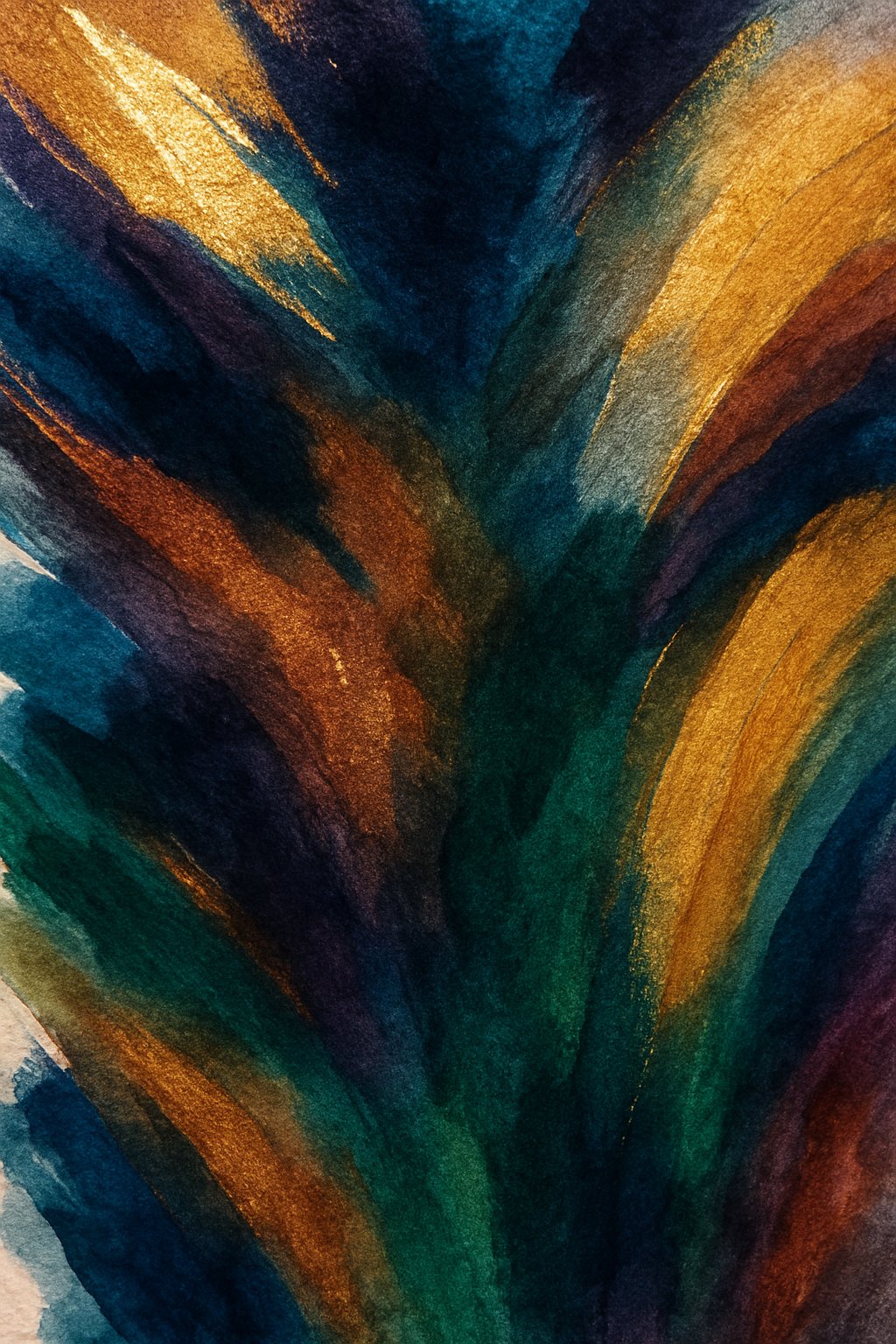
Artists can also experiment with metallic paints in mixed-media projects or use them to enhance specific elements like night skies, floral designs, or calligraphy. Choosing high-quality brushes and paper helps achieve smooth blending and precise application. This approach makes it easier to control the reflective qualities that make metallic watercolors stand out.
Understanding Metallic Watercolor Paints
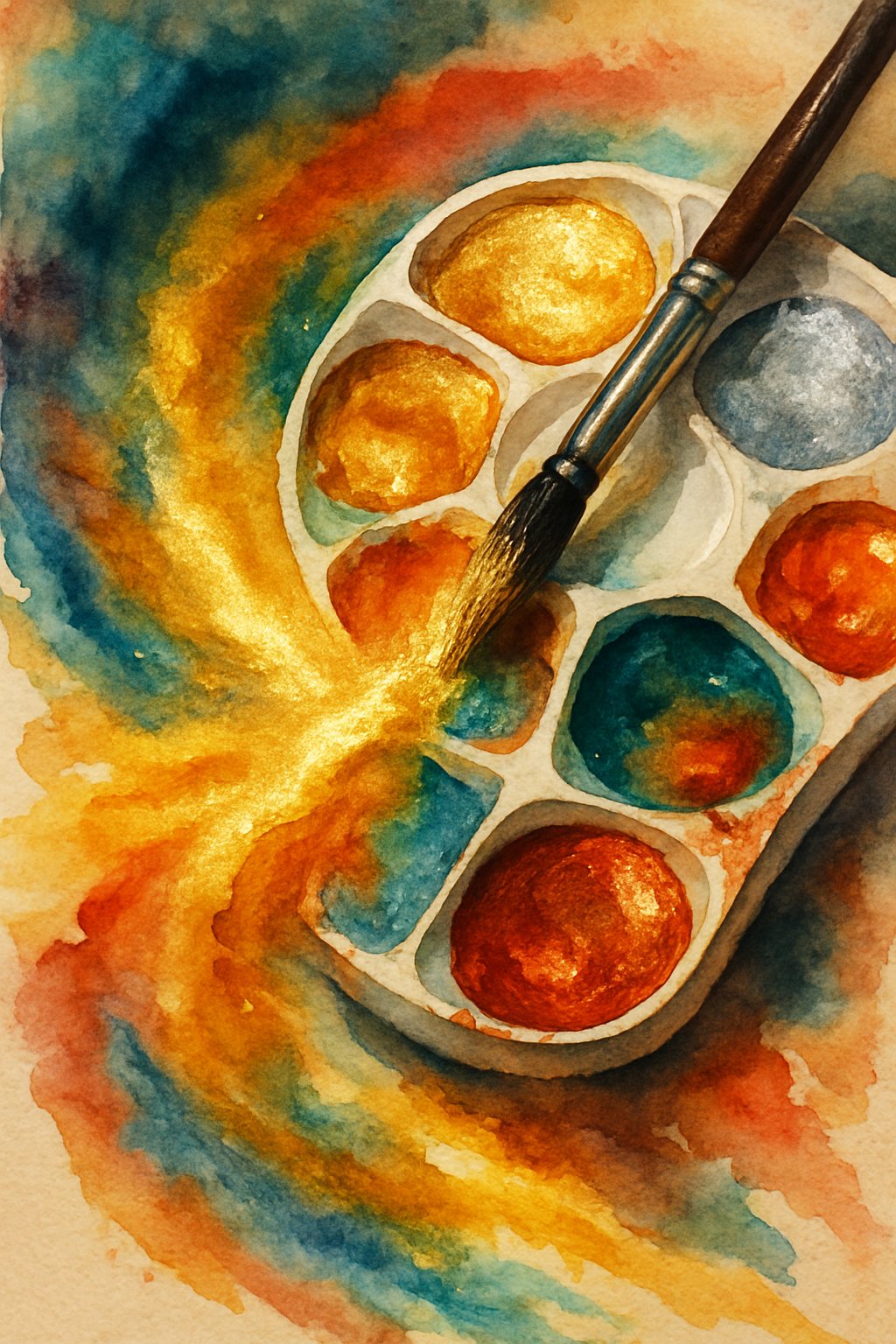
Metallic watercolor paints add a unique shimmer and shine that traditional watercolors do not have. These paints use special pigments that reflect light differently. Artists can choose from many colors and finishes to create various effects in their paintings.
What Sets Metallic Watercolors Apart
Metallic watercolors differ from regular watercolors because they contain metallic pigments. These pigments are tiny particles made from metals like aluminum or mica. They sit on the paper’s surface rather than fully absorbing into it.
This gives metallic watercolors a reflective quality and a subtle texture. The paints tend to be more opaque and vibrant. Artists often use metallics to highlight parts of their artwork or to add depth and light.
How Metallic Pigments Create Shimmer
The shimmering effect in metallic watercolors comes from how metallic pigments reflect and scatter light. Unlike typical pigments, metallic particles have flat, shiny surfaces.
When light hits these surfaces, it bounces off, creating a glowing, metallic sheen. This effect changes depending on the light angle and the viewer’s position, adding a dynamic visual element to the painting.
Because metallic pigments do not mix fully with water like other pigments, the paint can create a slightly raised or textured surface.
Range of Available Colors and Finishes
Metallic watercolors come in a wide range of colors beyond just gold and silver. Common metallic shades include:
- Gold
- Silver
- Bronze
- Copper
- Pearlescent blue, green, and red
These paints may have different finishes, such as shiny gloss or soft pearlescent. Some sets include colors that change appearance depending on light and angle. This variety lets artists use metallic watercolors in many styles, from detailed botanical illustrations to bold abstract landscapes.
Selecting Materials for Metallic Watercolor Art
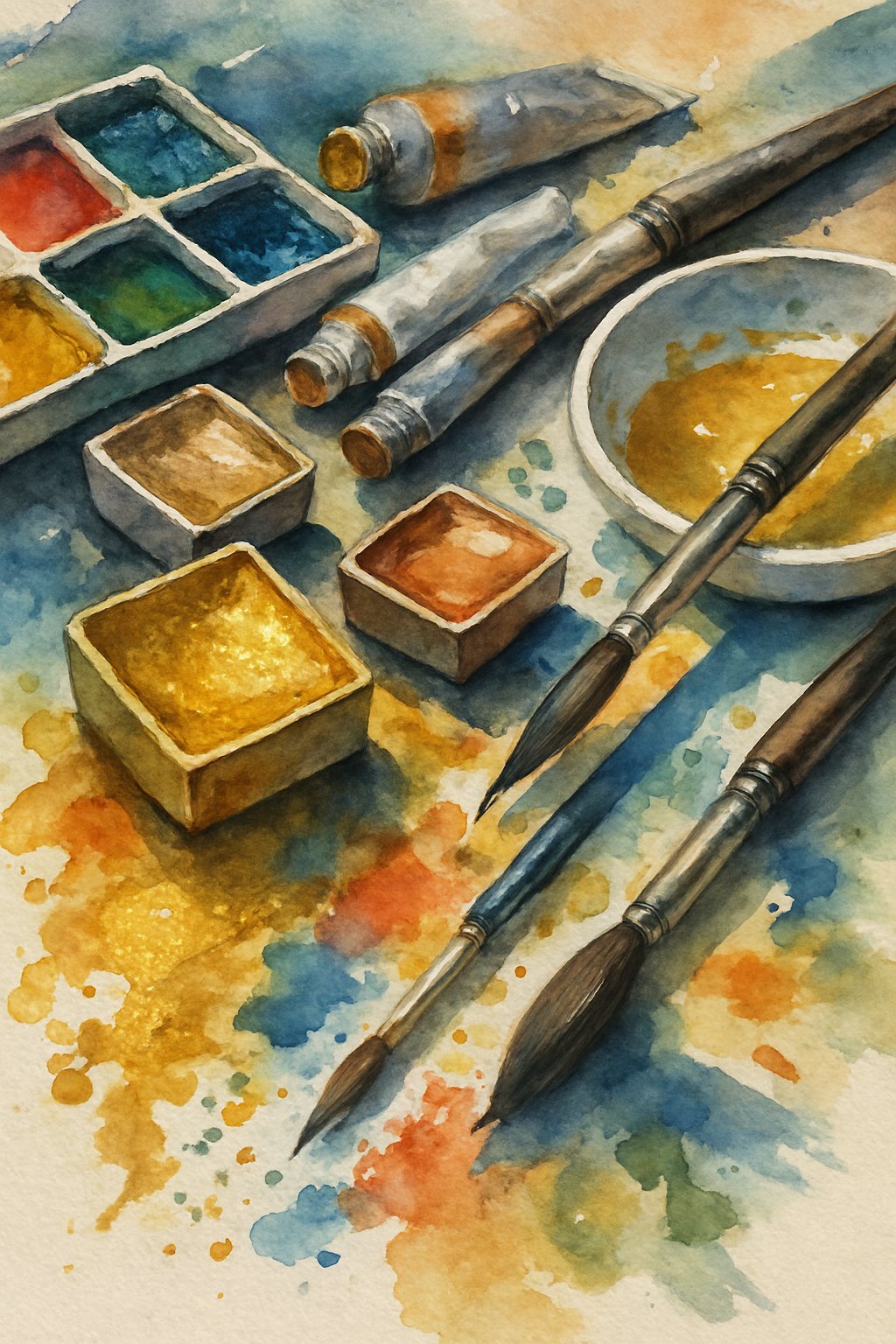
Choosing the right materials affects how metallic watercolor paints behave and appear in a painting. The quality of paint, paper, and brushes plays a major role in achieving crisp lines, vibrant shimmer, and smooth application. Careful selection supports better control and a polished final piece.
Choosing High-Quality Metallic Paints
High-quality metallic watercolor paints have intense pigmentation and a strong reflective sheen. These paints include fine metallic particles that create shine without overpowering the colors.
Look for paints labeled specifically as metallic watercolors, as non-metallic paints mixed with glitter may lack consistency or durability. The pigment concentration matters because it influences brightness and how long the paint lasts after drying.
Metallic paints from reliable brands often have smooth flow and mix well with standard watercolors. This allows artists to build layers and highlights easily. It’s important to test a few colors to find ones with the right balance of shimmer and opacity.
Selecting the Right Watercolor Paper
Watercolor paper must handle the extra texture and moisture metallic paints can bring. Papers with a weight of 140 lb (300 gsm) or higher work best to prevent buckling during layering.
Cold-pressed paper is preferred as it offers a slightly textured surface that holds metallic paint better and reflects light evenly. Smooth or hot-pressed paper can reduce the metallic paint’s shine by limiting how light interacts with the surface.
Cotton-based papers are durable and absorb paint evenly, enhancing the metallic effect. Papers made from wood pulp may not absorb well and can weaken under repeated washes.
Essential Brushes and Tools
Soft, high-quality brushes are key when working with metallic watercolors. Synthetic or natural hair brushes with a good spring hold paint well and apply it evenly.
Large flat brushes help cover broad areas with metallic paint, while small round or liner brushes add fine details and highlights. Using clean brushes for metallic paints prevents muddying colors and preserves shimmer.
Additional tools like artist masking tape can create sharp edges, while stencils help with precise, repeatable shapes. Using these tools maintains clear lines and enhances overall design quality in metallic watercolor artwork.
Foundational Techniques for Metallic Watercolor
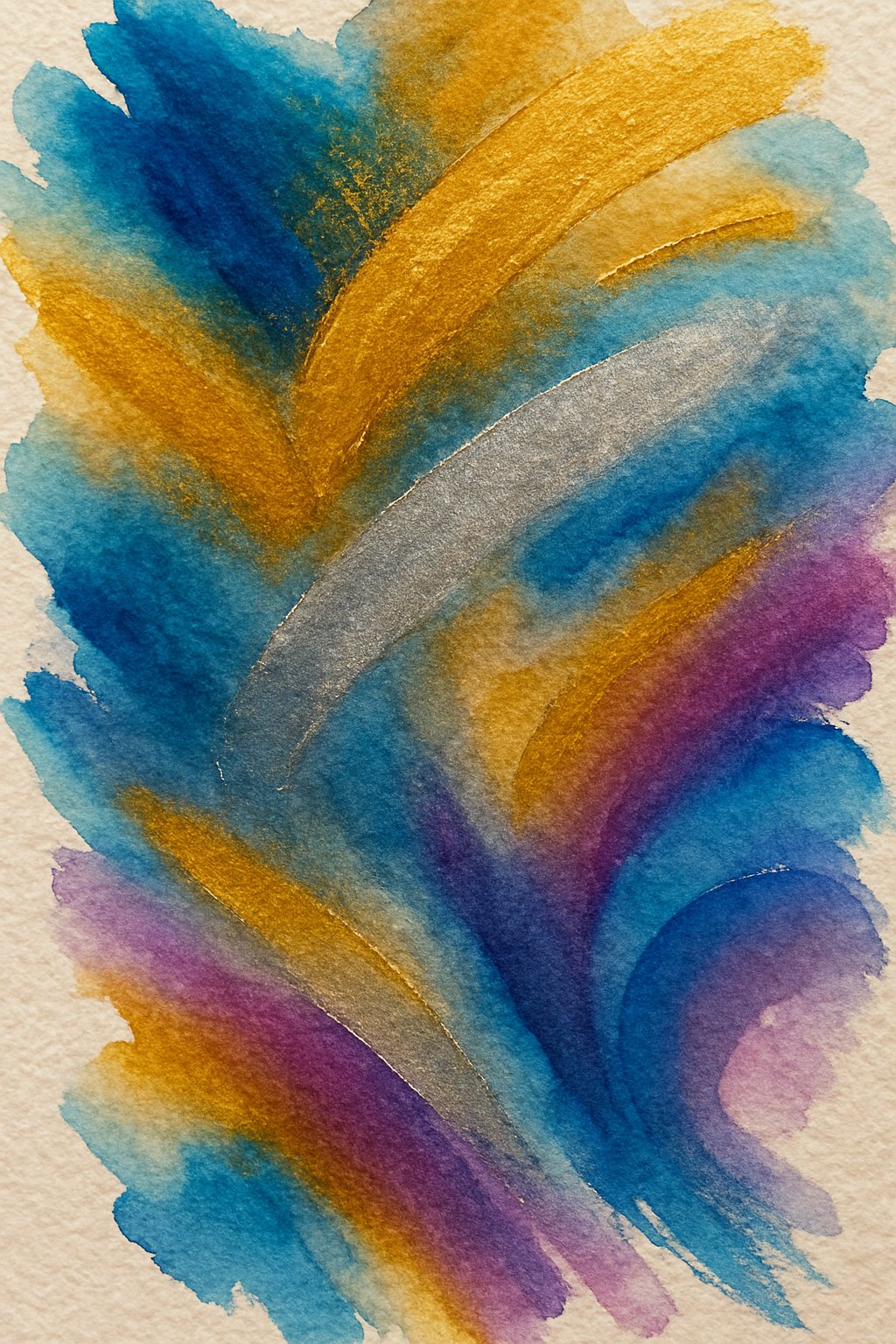
Using metallic watercolor paint requires careful control of layering and blending. Building up thin layers enhances shine and depth without dulling the metallic effect. Handling moisture properly is also essential for smooth, fluid color transitions.
Layering for Depth and Luster
Layering metallic watercolor paint helps create a rich, glowing effect. Artists should apply thin, transparent washes rather than thick paint. Each layer must dry fully before adding the next to avoid muddying colors or losing the metallic shine.
Starting with lighter shades and gradually adding darker tones builds depth. This method allows highlights to stay bright while shadows gain intensity. It is important to use a gentle touch, as too much paint can cover the shimmer.
Using black or dark watercolor paper can boost the metallic paint’s brightness between layers. This contrast makes metallic colors more vivid and reflective. Patience and steady application give the artwork a polished, luminous look.
Wet-on-Wet Technique for Fluid Effects
The wet-on-wet technique involves applying metallic watercolor on wet paper or wet paint. This method blends colors softly and creates smooth transitions. The metallic pigments float on the wet surface, producing natural highlights.
It is crucial to control the amount of water used. Too much water can dilute the metallic effect and cause colors to run. A lightly damp surface works best to maintain the paint’s intensity and shine.
Artists can drop metallic paint onto wet washes to create shimmering blooms or gradients. They must work quickly before the paper dries, as metallic watercolor works differently than regular paint, requiring faster strokes for the best fluid effects.
Creative Ways to Apply Metallic Watercolors

Metallic watercolor paints can be applied in various ways to add shine, texture, and depth to artwork. Different methods work well for highlighting, layering, or creating unique effects with metallics. These techniques often combine traditional watercolor skills with special handling of the metallic paint.
Dry Brush Technique for Texture
The dry brush technique works well with metallic watercolor paints to add rough, textured highlights. The artist loads a dry brush with a small amount of metallic paint and drags it lightly over dry paper. This method avoids full coverage and allows metallic paint to catch on raised paper textures.
It’s useful for emphasizing details like metallic reflections or adding sparkle to surfaces without coating them completely. Because the paint is applied thinly, the shimmer is subtle but effective. Using a stiff-bristled brush helps control the texture.
This technique is best for small areas where a dry, scratchy effect enhances the art, such as metal objects, stars, or light reflections.
Blending with Traditional Watercolors
Blending metallic watercolors with regular watercolors creates soft transitions between shiny and matte areas. Artists start by painting a base with traditional watercolors. Once dry or slightly damp, they layer metallic watercolor paints on top to add shimmer.
By adjusting water amounts, the metallic paint can spread or stay concentrated. This controlled blending enhances depth without overpowering the original colors. Soft brushes help achieve smooth gradients between metallic and non-metallic sections.
This method works well for backgrounds, skies, or floral art where a hint of shimmer improves the overall look while keeping a natural feel.
Combining with Gouache for Opaque Highlights
Combining metallic watercolors with gouache allows artists to add bold, opaque highlights that stand out. Gouache’s thick, chalky texture covers areas where metallic watercolors alone might be too transparent.
Artists can paint a metallic base layer, then use white or colored gouache to create sharp contrasts or add details over the metallic sheen. Alternatively, applying gouache first and then adding metallic highlights offers a layered effect with solid colors under the shimmer.
This approach suits art requiring precise shiny accents, like jewelry or decorative patterns, where both opacity and metallic shine are needed.
Enhancing Artwork with Metallic Effects
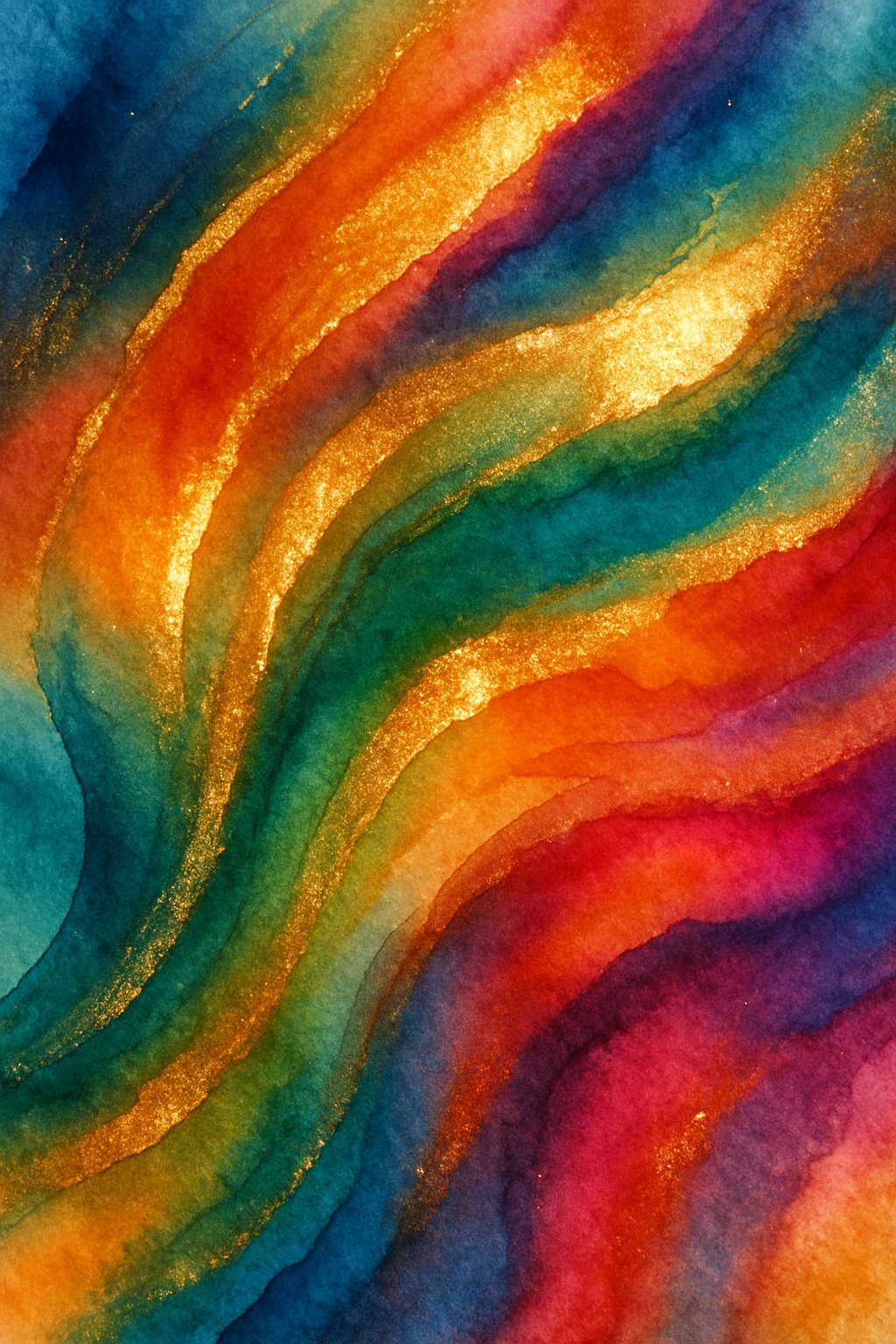
Metallic watercolor paint adds a shimmering effect that can lift details, create contrast, and highlight specific areas with a unique metallic sheen. Proper use of these paints ensures the artwork gains depth without losing clarity or balance.
Accenting Highlights and Fine Details
Using metallic watercolors to accent highlights or fine details brings subtle shine to focal points. Artists should apply metallic paint sparingly in thin layers to avoid a heavy, clumpy look. A small, damp brush is best to control the flow and build delicate shimmer.
Adding metallic accents on areas like leaves, jewelry, or reflective surfaces can make these features stand out. It’s important to wait for layers to dry before adding more to keep transparency and avoid dullness. This method enhances dimension by letting light catch the metallic pigments naturally.
Using Metallics Over Dark Backgrounds
Metallic paint works well over dark backgrounds because it reflects light, creating strong contrast. When painting on black or deep tones, the metallic sheen shines brighter and appears more vivid.
Artists should use thinner layers with a controlled brush to prevent streaks or uneven shine. Layering metallic paint over dark areas can mimic moonlight or stars, adding visual interest and shimmer. The key is to build color gradually, preserving the paint’s reflective quality.
Integrating Metallics in Lettering and Calligraphy
Metallic watercolors are ideal for adding sparkle and sophistication to lettering and calligraphy. The shimmering effect draws attention to letters, making words pop on the page.
For the best results, calligraphers select fine-tipped brushes to keep lines crisp and precise. Metallic paints should be applied lightly to avoid bleeding, ensuring clean edges. This technique works well on high-quality, smooth paper that supports even paint flow and prevents color dulling.
Special Project Ideas for Metallic Paint
Metallic watercolor paint suits many creative projects beyond traditional paintings. It can add a festive look to holiday cards or invitations, creating glittery and elegant designs.
Artists might combine metallic paint with other media, such as gold leaf or foil, for mixed-media effects. Metallic accents also brighten black and white floral illustrations by adding subtle, eye-catching sheen. Practical uses include decorating journals, scrapbooks, or small crafts that benefit from an artistic shimmer.
Tips for Best Results in Metallic Watercolor Art

To get the best effect from metallic watercolor paints, attention to detail is key. Proper surface preparation, smart color mixing and layering, and careful preservation all play important roles in producing bright, lasting artwork.
Preparing and Priming Your Surface
Choosing the right watercolor paper is essential. Heavier weight paper (140 lb or more) with good texture holds metallic pigments well and prevents warping.
Before painting, lightly mist the paper or use a flat wash to prime it. This helps the metallic paint spread smoothly and enhances its shine.
Avoid overly rough or hot-pressed paper for metallics, as it can dull the reflective qualities of the pigments. Using a clean, soft brush will also help apply paint evenly without disturbing the metal particles.
Mixing and Layering Colors Efficiently
Metallic watercolors often have thicker pigments that settle quickly. Stir paints gently before use to mix metallic particles evenly without creating bubbles.
Layer colors gradually, allowing each layer to dry. This builds depth and prevents the metallic shine from becoming muddy or hard to see.
When mixing metallics with regular watercolors, test the mix on scrap paper first. Some colors can dull the metallic effect. Using a small brush for highlights and a larger one for washes can create sharp contrasts.
Protecting and Preserving Finished Pieces
After drying completely, artworks with metallic paints owe their shine to proper sealing. Use a spray fixative designed for watercolor to protect against smudges and fading.
Keep paintings out of direct sunlight, as UV rays can reduce the brightness of metallic pigments over time.
When framing, place glass or acrylic with UV protection at a small distance from the paper to avoid sticking. Store paintings flat or upright in a dry place to prevent curling or damage.
Frequently Asked Questions

Metallic watercolor paints require specific techniques and materials to achieve the best effects. Understanding paper choice, layering methods, and mixing helps artists unlock their full potential. Preservation of the metallic shine and creative uses in mixed media also play important roles.
What are the techniques for layering metallic watercolor paints?
Artists often apply metallic watercolors in thin, transparent layers to build up shine gradually. Let each layer dry completely before adding the next to avoid dulling the metallic effect. Using a soft brush helps keep the surface smooth and reflective.
Which paper types are best suited for metallic watercolor artwork?
Heavyweight, textured watercolor paper works best, especially cold-pressed or rough papers. These papers hold the paint well and enhance the metallic shimmer. Smooth hot-pressed paper can be used for fine details but may lessen the shine.
How can you mix metallic watercolors to create custom shades?
Mix metallic paints carefully with regular watercolors to avoid losing shimmer. Combining small amounts preserves the metallic quality. Using a palette helps control ratios and allows gradual blending of colors to create unique tones.
What are some creative applications for metallic watercolors in mixed media art?
Metallic watercolors add shine to calligraphy, floral sketches, and background washes. They blend well with ink, pencil, and collage materials. Artists use them to highlight details or create festive, eye-catching effects within layered artwork.
How do you preserve the sheen of metallic watercolors in your finished piece?
Applying a clear, non-yellowing varnish protects the metallic paint from dust and damage while maintaining gloss. Avoid heavy water after finishing, as moisture can dull the finish. Storing artwork away from direct sunlight also helps preserve shine.
Can you provide tips for beginners working with metallic watercolor paints?
Start with light washes and build layers gradually to avoid overloading the paper. Use good quality brushes that hold water but allow control. Experiment on scrap paper to test color and shimmer before applying to the final piece.
